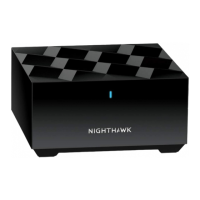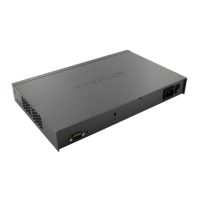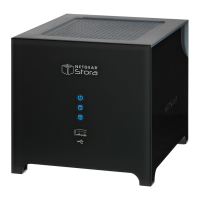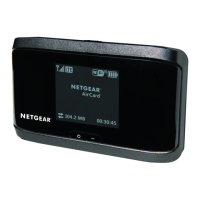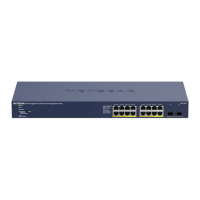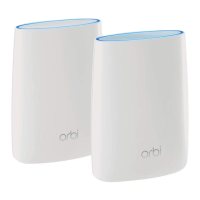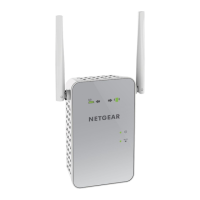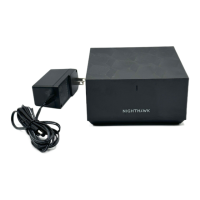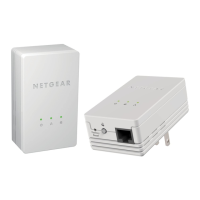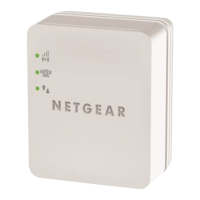
Do you have a question about the NETGEAR WN1000RP and is the answer not in the manual?
| Maximum data transfer rate | 300 Mbit/s |
|---|---|
| Wi-Fi | Yes |
| Frequency band | 2.4 GHz |
| Connectivity technology | Wireless |
| Security algorithms | WEP, WPA, WPA2-PSK |
| Certification | RoHS, CEC, WEEE |
| Networking standards | IEEE 802.11b, IEEE 802.11g, IEEE 802.11n |
| Weight | 100 g |
|---|---|
| Dimensions (WxDxH) | 67 x 55 x 34 mm |
Explains the booster's function as a bridge between a WiFi router and wireless devices, acting as a client and an access point.
Provides recommendations from NETGEAR on optimal usage scenarios for the booster, focusing on weak network connections.
Details the physical components of the booster, including LEDs for status and connectivity, and buttons for power and WPS.
Step-by-step guide on connecting the power, positioning the booster, powering it on, and connecting a device for initial setup.
Guidance on placing the booster for optimal signal strength, emphasizing line of sight and distance between router and devices.
Explains how Link Rate LEDs indicate wireless connection performance and provides tips to improve booster performance.
Instructions on accessing the booster's web interface via http://www.mywifiext.net to view or change settings.
Guidance on utilizing the NETGEAR genie software to set up the booster to connect to a wireless network using the Setup Wizard.
Explains how to use WPS (Wi-Fi Protected Setup) to easily connect wireless devices to the booster's network.
Overview of the Setup Menu, allowing users to view and modify booster settings after the initial setup is complete.
How to customize the booster's network name (SSID) and configure wireless security options like WEP, WPA, and WPA2.
Details on configuring the booster's IP address settings, either dynamically from the router or with a static IP address.
Accessing maintenance functions such as viewing status, managing attached devices, backing up settings, and updating firmware.
Information displayed on the Status screen, including hardware and firmware versions, network connection status, and IP details.
How to view detailed performance statistics for the wireless LAN (WLAN) ports, including packet counts and bandwidth usage.
Viewing a list of devices currently connected to the booster's network via the Maintenance menu.
Procedures for backing up and restoring the booster's configuration settings, as well as reverting to factory defaults.
Instructions for changing the default administrator password to enhance the security of the booster's settings.
Steps to check for, download, and install new firmware versions for the booster to improve functionality and security.
An overview of advanced configuration options available for the booster's wireless settings.
Configuration options for SSID broadcast, WPS settings, and managing wireless access control lists (MAC filtering).
Addresses common user issues such as NETGEAR genie prompts, Ethernet connection queries, and MAC filtering setup.
Troubleshooting steps for connection issues to the booster's setup URL and guidance on interpreting LED indicators.
Solutions for problems encountered when the booster fails to connect to a selected WiFi network or obtain an IP address.
Instructions on how to reset the booster to its original factory default configuration using the dedicated button.
Provides detailed technical information including network compatibility, physical dimensions, environmental operating conditions, and interface standards.
User requirements for operating the product according to national laws, radio spectrum usage, and firmware limitations.
Details compliance with EU directives (EMC, Low Voltage, R&TTE) and specifies intended use within EU member states.
Information for US users regarding FCC rules, including prohibitions on user-serviceable components and product modifications.
Compliance with FCC radiation exposure limits for uncontrolled environments and recommended minimum installation distance.
NETGEAR's declaration that the WiFi Booster for Mobile WN1000RP complies with FCC CFR47 Rules Part 15 Subpart B.
Guidance on FCC Class B digital device compliance, methods to correct interference, and essential user cautions.
A note for CATV System Installers regarding coaxial cable grounding as per the National Electrical Code.
Information on digital apparatus radio-noise emissions compliance with Canadian regulations, including ICES-003.
Compliance with Industry Canada RSS-210 rules, specifying conditions for operation and interference acceptance.
A table listing recommended minimum distances between NETGEAR equipment and common household appliances to minimize interference.
